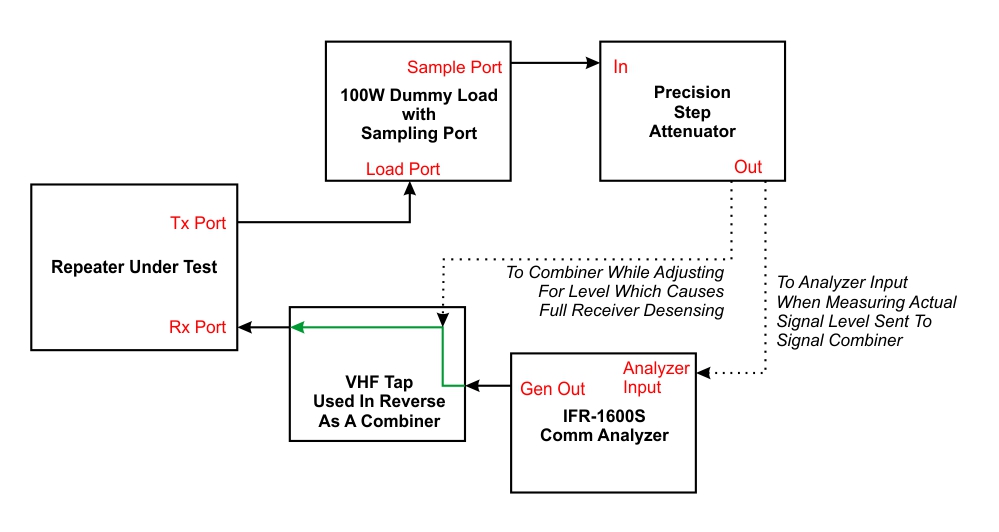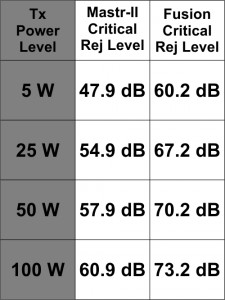Okay, so your old Mastr II was pumping out 50, 75, maybe even 100 Watts with no problem using your trusty old duplexers, but then you installed a shiny new Yaesu Fusion and the proverbial “stuff” hit the fan. Desense galore. Poor sensitivity. User complaints about not being able to carry on a QSO like before — all other factors being equal. You’ve even tried backing the Fusion’s transmit power down to half or less of what you’d been running the old Mastr II’s PA at (or maybe it’s a Motorola) but you still feel as though you’re chasing your tail. I’ve received countless calls, messages, emails, etc. asking for help and advice with this problem. I have known since my very first encounter with a Fusion repeater essentially what the problem was — and various solutions — but today I actually went to the effort to do in-depth technical testing and put some real numbers with it. In all honesty, it’s a bit worse than I had estimated.
The problem is one of “selectivity” — not to be confused with “sensitivity.” Two totally different beasts. My testing does show the sensitivity of the Yausu Fusion to be pretty close to that of the Mastr II and other commercial grade repeater equipment. Where it can’t compare is in selectivity — the ability of the receiver to effectively hear what it’s supposed to while suppressing and not getting swamped by other signals, including (especially) its own transmit frequency. Because the Fusion is much less selective (just how much so you’ll see shortly) you can’t get the same performance out of the Fusion that you were accustomed to with a Mastr II, Motorola, or other truly commercial grade repeater if you try to use the same duplexers. High RF environments such as broadcast transmitter sites or sites with multiple repeaters in operation also become a problem at times with the Fusion; whereas, the old Mastr II and other systems seemed to work okay.
There are a combination of factors which make the receiver in one repeater more or less selective than others. I’ll spare you all the discussions of “Q” and how amplifiers, transistors, etc. actually lose gain at the desired receiver frequency when there’s a lot of RF on frequencies close to it (such as just 600 KHz or so away — typical of ham repeater in the 2-Meter band), but we can’t avoid mentioning it altogether. True, your duplexers help reduce much of the unwanted signals, but they never block 100% of it. The less selective the repeater’s receiver is, the more isolation between the receive and transmit frequencies is needed in the duplexers. By contrast, higher selectivity in the receiver means you can get away with lower “dB” isolation in the duplexers. For example, a Mastr II might work fine at 50 Watts on a high quality set of 4-cavity duplexers, or at 100 Watts on a 6-Cavity set, but the Fusion often takes repeater owners on a not-so-fun journey into desense land at 50 Watts (sometimes 25 Watts) on the same 4-cavity set that the Mastr II had played nicely with in the past. My testing this morning shows how much so.
In order to conduct side-by-side, “apples to apples” testing for comparison purposes, here’s how I set everything up and conducted the tests.

With the setup above, I sent a signal from the IFR-1600S to a combiner, the output of which was in turn routed to the receiver port of the repeater being tested. With the repeater activated, the transmitter output was sent to a 100 Watt dummy load with a reduced level sampling port. The output from that sampling port was then fed to a precision attenuator capable of 1-101 dB attenuation in 1 dB steps, the output of which was combined with the IFR’s output at the second input port of the combiner. This setup allowed me to combine a precisely adjustable amount of the transmitter’s output signal with the desired receive signal. By slowly decreasing the amount of attenuation of the transmit signal allowed into the combiner, I was able to determine how much RF power getting back into the repeater’s receiver would cause desensing. I kept adjusting until the level of the transmit signal going back into the combiner was high enough to cause total desensing of the receiver, meaning that the receiver was unable to discern enough receive signal to even do “cyclic” type key/unkey/key/unkey repeated desensing. The levels I created and measured resulted in total loss of useable reception in the receiver, effectively deafening and shutting down the repeater’s functionality altogether.
It is important to note that this testing does not address the levels at which “white noise” from the transmitter starts causing voice/modulation quality degradation in the repeater’s output. “White noise” and transmitted voice/modulation quality actually start occurring at much lower levels of unwanted transmit RF getting back into the receiver. Such noise gets progressively worse as the level of unwanted signal creeping back into the receiver increases, until it reaches the total desense level. Thus, the amounts of transmit/receive isolation needed (discussed a bit later in this article) in order to have clear, enjoyable QSO’s is actually considerably higher than the levels of rejection/isolation necessary just to avoid total desensing. Don’t use the isolation numbers shown in a bit to be the duplexer performance level you need for your repeater. Rather, the levels discussed in this article allow side-by-side comparison of the selectivity — or ability of each repeater’s receiver to block troublesome, unwanted signals and actually “pick out” and properly demodulate the desired signal.
For testing purposes, I used the following signals:
- Rx signal for the repeater: 147.660 MHz, modulated with a 1 KHz audible sine wave tone modulated at 3.0 KHz deviation, and a 123.0 Hz CTCSS tone modulated at a 0.6 KHz level for repeater PL tone operation. Signal level from IFR-1600S set to 0.224 uV for testing of both repeaters.
- Tx signal from repeater: 147.060 MHz with no tone generation being added by the repeater.
I chose these particular frequencies and tones for a simple reason: I had recently done a Mastr II repeater conversion for a local amateur radio club using that frequency pair and tones but it was still here in the lab, so a well functioning, properly aligned Mastr II set up as such was readily available. The Yaesu Fusion — being fully programmable and agile — was thus easy to set for identical frequencies and CTCSS operation.
Once I fired up each of the repeaters and had adjusted the level of the transmit signal being intentionally looped back into the receiver so that total desense occurred, I simply disconnected the feedback line from the combiner, which allowed the repeater to start repeating again. The level of the transmit signal coming from the test port of the dummy load and going into the precision attenuator had been measured just before conducting each desense level test. By calculating the resulting level after attenuation and factoring back in the amount of loss presented by the combiner, I was able to calculate the power level (calculated in uW (microwatts) in this instance) and record it. After putting both repeaters through this same test, I had the desired numbers at hand. I already knew that the differences between the Mastr II and Fusion would be noticeable, but they turned out to be a bit more so than I had suspected.
The Fusion repeater would totally desense with unwanted transmitter signal power of 4.77 uW. Contrast that to 80.8 uW that it took for the G.E Mastr II to reach total desense and a lot of things start becoming clearer. This table lists what I’ll refer to as the “Critical Rejection Level” — the amount of transmitter/receiver isolation necessary to prevent total desensing of the receiver for each

repeater. The table shows this estimated value calculated for operating each repeater at four power levels: 5, 25, 50, and 100 Watts. Please keep in mind, as mentioned before, that these are not intended to be absolute values to use for specifying duplexer parameters, etc. They are, however, numbers useful for comparison of the selectivity and desense avoidance capabilities of the Fusion and Mastr II. In my overall experience, the amount of transmitter/receiver isolation necessary to actually have relatively white noise-free, clear QSO’s in a repeater are generally 30-40 dB or so greater than what I refer to as the Critical Rejection Level. Shooting the middle and adding 35 dB to the numbers in this table yields numbers very comparable to the actual values of duplexer Tx/Rx isolation I’ve found necessary in real-world practice. I have found that the G.E. Mastr II VHF repeater will typically operate well in a relatively RF-clean environment with 80 dB or greater Tx/Rx isolation up to around 40 Watts, and do well up to 100-125 Watts with at least 100 dB of isolation. By contrast, the Yaesu Fusion is best operated with at least 80 dB of duplexer Tx/Rx isolation at 25 Watts or less, and definitely needs 100 dB or better in order to operate at its 50 Watt transmitter power level or with an outboard power amplifier running between 50 and 100 Watts (again, in a relatively CLEAN RF environment.) Also, these numbers relate only to transmitter/receiver isolation. Operating a repeater in a high-RF environment such as a commercial/broadcast transmitter site will create the need for specialized filtering (such as pre-filters), increased duplexer isolation rating needs, and frequently create intermodulation problems that call for lots of creativity and sometimes end up being impractical to try to overcome. I also have not done extensive testing to see whether or not the Fusion’s transmitter final/PA output is as good as the Mastr II in terms of any harmonics, spurious artifact, etc. in its “Fixed Analog FM” output mode. I suspect that it isn’t, but that’s research for yet another day. For now, suffice it to say that if it’s not, then things get even worse, but for the moment let’s at least imagine that the Fusion and the Mastr II have exactly the same output signal quality.
I am considering repeating these tests using the Fusion in UHF/70CM band and a Mastr II running at the same frequency/band. Almost all complaints I’ve heard regarding the Fusion having desense problems have been in the 2-Meter band, so that was my focus for today’s testing and documentation purposes.
I hope that this information sheds some light on why Fusion repeaters installed as replacements for Mastr II repeaters (and other commercial grade repeaters, such as Motorola equipment) so often create frustration and sleepless nights for so many repeater operators. My hat is off to the folks at Yaesu for creating some exciting, feature-rich repeaters in a price range that put them within the reach of many repeater owners who thought they’d never own a brand-spanking new repeater. Anyone considering purchasing a Fusion just needs to keep in mind that Fusion repeaters are ultimately ham/consumer level equipment and understand that they will not perform as well for analog communications as will a Mastr II or other commercial/professional grade repeater. Installing a Fusion using the same antenna, duplexers, connectors, and other hardware that was previously used with a properly working and aligned commercial grade repeater can and will quickly lead to great frustration unless you’re prepared to make a combination of changes and/or concessions.
73 Everyone!